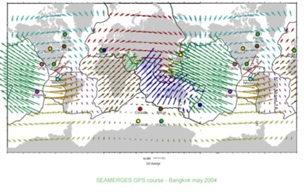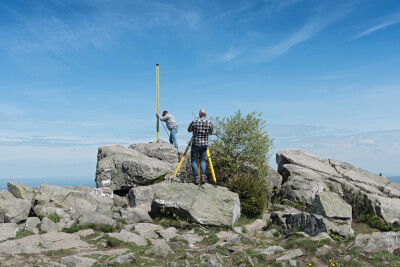Terrestrial photogrammetry is used more and more in three-dimensional modeling. There are a few principles that are worth knowing to maximize the effectiveness of such work.
When you take a picture of an object, light rays from the object travel in a straight line from the object through the center of your camera and onto the film plane which these days likely contains a CCD chip. While it is true that these light rays form a negative image of the object on the film plane, from a mathematical viewpoint the virtual positive image of the object is formed on the virtual film plane in front of the center of the camera.
The center of the camera is known as the perspective center and it is the origin of the image coordinate system. This is very useful because if you know the position of the perspective center of the camera you know that any object point that interests you must be somewhere on the straight line defined by the perspective center and that object point’s representation on the image. You can nail down the exact position of your object point on that line by measuring the same point in another image of the same object. The object point’s actual location is right at the intersection of the two lines.
Sounds great, but the whole process depends on you knowing the location of the perspective center of the camera. Fortunately it can be found by resection. To do that you need at least three control points with known 3d coordinates in the images. Once you have these points you can calculate both the location and orientation of the camera station. Unfortunately making sure there are at least three control points in each image is a pretty high hill to climb. There’s another way.
By grouping a set of images into a package called a block the need for control points in each image is reduced. This arrangement means that control is only needed for the block itself not each individual image that makes up the block. However, there are some rules. Each individual image must overlap with one or more other images in the block. There must be at least one common tie point (TP) between each group of 3 connected images. In other words, the tie pointsare image points. They are photo-identifiable points located in overlapping images. There also must be stereo coverage throughout the block meaning that each image must be taken from a different perspective location.
The good news is that with sufficient control in the block you can now compute a resection and calculate the blocks location and orientation. Once that is accomplished you can then use that information to compute the locations and orientations of the individual images that compose the block. However, the construction of the block of images requires the use of several techniques. One of them is relative orientation in which you tie each of the images together by identifying common points found in them. Then bundle block adjustment or triangulation is used to tightened up their relative orientation.
A least squares estimation process is used to determine the exact location and orientation of each photo in a block at the instant of exposure. The process can be illustrated by image rays. Those rays are shown in the figure as the lines from the photographs to the surface. Each of these rays connects an object point, the perspective center of the image, and the projection of the object point on the image. Each image is a bundle of these rays. Using these bundles along with control information and tie points a bundle block adjustment can establish the position and the exterior orientation of all of the photographs in a block simultaneously. In other words the bundle block adjustment determines the three translations: X0, Y0, Z0 and the three rotations: ω,ϕ,κ required to bring all the corresponding rays to intersection as nearly as possible at the tie points and the control points.






